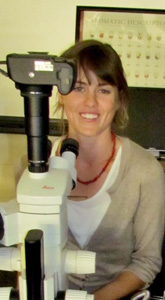
On June 15, 2013 Sheridan College hosted 2013 Sheridan R&E Center Field Day, open to the public. The field day started at 8:30 a.m. and finished at 5:30 p.m. It was an opportunity for Sheridan College Agriculture Department to share their current research projects, research projects including : 1) evaluation of alfalfa; 2) small grain variety trial; 3) sainfoin variety trial; 4) homeowner turf trial; 5) biofuel crops study; 6) utilization of CBM discharge water; 7) establishment of mints as a specialty crop for Wyoming; and 8) optimization of high and low tunnel organic vegetable systems for the Sheridan area. A new project involves the evaluation of table and wine grape cultivars for Wyoming. The goal is to identify promising grapevine cultivars for Wyoming, thus overcoming obstacles to initial vineyard establishment, resulting in increased production and early returns. The day was filled with several important tours, presentations and social networking. The day started with tours at Wyarno Research Station and migrated to the science building on the campus. Although I was not present for the first half, having to tend to time sensitive research project, the second half was filled with a dynamic line-up of presentations which highlighted the projects underway in Sheridan and Wyoming at large.
Homeowners Session – Presentations:
- Backyard Composting – Phil Gilmore, Landons’ Greenhouse
- Drip Irrigation for Small Vegetable Farms – Axel Garcia y Garcia, UW
- Edible Landscaping with Small Fruits and Berries – Connie Fisk, Sheridan College
- Growing Fruit Trees in Wyoming – Chris Hilgert, UW
- Growing Wyoming Agriculture – Donn Randall, Wyoming Business Council
- Landscaping with Native Perennials – Ami Erickson, Sheridan College
- The Last Frontier – Wyoming Wine Country – Patrick Zimmerer
Ranchers Session – Presentations:
- Estabilishment and Management of Alfalfa – Anowar Islam, UW
- Grasshopper Control on Rangeland and Cropland – Alex Latchininsky, UW
- Hay Production of Cool Season Perennial Forage Grasses – Blaine Horn, UW Extension
- Irrigation Scheduling for Forage Crops – Axel Garcia y Garcia, UW
- Range Inventory and Monitoring – Keith Klement, Sheridan College
- Reclamation of Disturbed or Degraded Rangelands Principles and Practices – Brian Mealor, UW
- Solar Powered Livestock Water Pumping: Technical and Economic Feasibility – Milt Geiger, UW Extension
- Weed Control in Forages – Andrew Kniss, UW
As a land-grant university, University of Wyoming is upholding its mission of combining learning, research and utilizing the extension system for community outreach to support farmers, ranchers and gardeners, and, the challenges they face in the 21st-century. As a student, I was enthusiastic to present our Biotechnology research lab, describe our work on grape genetics, its importance and answer challenging, often controversial questions. The Sheridan Agriculture building is currently being renovated, thus, we are challenged by working in less than ideal conditions. However, I was eager to impart my enthusiasm and knowledge on Grape Biotechnology Research.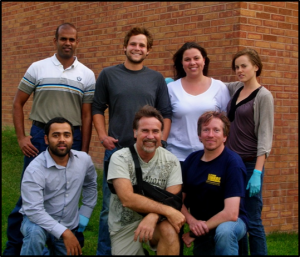 The research we are conducting is an important educational resource to the University of Wyoming students. Not only students from UW College of Ag and Natural Resources can benefit from this research. There are students from Sheridan Community College who are working in the biotechnology lab. Braxton Tyree is an undergraduate, who is working towards entering into medical school with aspirations to study internal medicine. In addition, Duane McMurty is a student in the College of Engineering working towards a bachelor degree in chemical engineering. The biotechnology research provides opportunity to build skills and knowledge on the molecular level which is of benefit for students who seek to be more well-rounded in their future careers. In addition, I am continuously inspired by Dr. Dhekney (the professor behind horticulture biotechnology) and his ability to work in a less than ideal ‘laboratory environment’. The future is bright, not only will the research become more efficient with new facilities, it will provide vast opportunities ranging to potential student research opportunities, adding jobs to the economy and helping to develop Wyoming’s agriculture industry not only with grapes but additionally spans to research on forage crops and reclamation plant species.
The research we are conducting is an important educational resource to the University of Wyoming students. Not only students from UW College of Ag and Natural Resources can benefit from this research. There are students from Sheridan Community College who are working in the biotechnology lab. Braxton Tyree is an undergraduate, who is working towards entering into medical school with aspirations to study internal medicine. In addition, Duane McMurty is a student in the College of Engineering working towards a bachelor degree in chemical engineering. The biotechnology research provides opportunity to build skills and knowledge on the molecular level which is of benefit for students who seek to be more well-rounded in their future careers. In addition, I am continuously inspired by Dr. Dhekney (the professor behind horticulture biotechnology) and his ability to work in a less than ideal ‘laboratory environment’. The future is bright, not only will the research become more efficient with new facilities, it will provide vast opportunities ranging to potential student research opportunities, adding jobs to the economy and helping to develop Wyoming’s agriculture industry not only with grapes but additionally spans to research on forage crops and reclamation plant species.
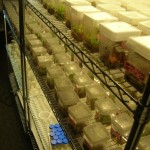
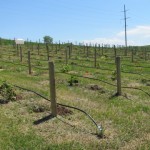
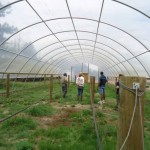 The Sheridan field day not only provided us this unique opportunity, it additionally gave students the opportunity to attend the presentations and do a bit of social networking. I was able to attend Wyoming Wine Country by Patrick Zimmer, Growing Fruit Trees in Wyoming by UW Master Gardner Extension Coordinator Chris Hilgert, Drip Irrigation for Small Vegetable Farms by Axel Garcia y Garcia and Edible Landscaping with Small Fruits and Berries by Connie Fisk. I would have attended them all because the quality of information presented help to educate me in a way that is not present in the classroom. I enjoy learning from experts first hand and this definitely complimented my college education. I listened to interesting questions asked by long-time growers, then sought out to speak with some of those individuals. I want to develop my skillset and knowledge on these topics so I am able to pass this on to Student ACRES farm, future generations of producers, small grower hobbyists and whoever else is interested!
The Sheridan field day not only provided us this unique opportunity, it additionally gave students the opportunity to attend the presentations and do a bit of social networking. I was able to attend Wyoming Wine Country by Patrick Zimmer, Growing Fruit Trees in Wyoming by UW Master Gardner Extension Coordinator Chris Hilgert, Drip Irrigation for Small Vegetable Farms by Axel Garcia y Garcia and Edible Landscaping with Small Fruits and Berries by Connie Fisk. I would have attended them all because the quality of information presented help to educate me in a way that is not present in the classroom. I enjoy learning from experts first hand and this definitely complimented my college education. I listened to interesting questions asked by long-time growers, then sought out to speak with some of those individuals. I want to develop my skillset and knowledge on these topics so I am able to pass this on to Student ACRES farm, future generations of producers, small grower hobbyists and whoever else is interested!
This summer has definitely kept me on the go. A typical day consists of rising at 5:20 a.m. and making my way out to the vineyard to fill the irrigation tank. After that I proceed to the community garden to pull a few weeds and drench the soil for those thirsty plants. Work usually begins at 8:00 a.m., however, I generally make it earlier because I am “up and at it”. Then the day is paved way with a long day of lab work. More often than not the experiments we follow are concise, tedious and time consuming. It’s not uncommon for us to work 10-12 hour days. It reminds me of being a farmer and a song I heard on the country radio station. It was a country super star singing away about the life of a farmer, something along the lines of no matter how tired a farmer may be, he doesn’t show it. He keeps on going until the work is done. Even though we are not in the field, we are essentially doing the same work but in a molecular field. It’s exciting, interesting and is full of difficult challenges that can only lead to great things.
In addition to campus work, I was able to do a bit of travelling. Myself and three other members from Student ACRES farm travelled to the east coast for a week. We attended a conference hosted by the University of Delaware called, “Earth Perfect? Nature, Utopia and the Garden. This was made possible by SEND Grant donors, Ms. Mary Ellbogen- Garland. At the conference we presented ACRES model of student farming and unique role in the on campus and off-campus community. It was delightful to gain such interest and positive feedback on our presentation, with professors and students from a couple universities. For example, the University of Delaware is in the initial stages of planning a student run farm. The students attended our presentation, gained insight and information to contribute to personalizing their own farm. We also had the opportunity to attend several sessions, ranging on the topics of literary arts, philosophy, landscape architecture, politics of gardening, reclamation, science, fostering native habitats with plants, etc. 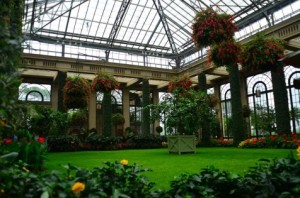 One of my favorite presentations was given by, Margaret Morton photographer and co-author of ‘Transitory Garden, Uprooted Lives’. She spoke about unconventional gardeners, those that would be considered homeless located in New York City. What she did was visit the homeless people in their places of dwelling throughout the city over a time period of several years. For example, there was a group of people living in an underground tunnel. She kept track with a gentleman who would nurture seeds that happened to fall through openings of the sidewalks and streets.
One of my favorite presentations was given by, Margaret Morton photographer and co-author of ‘Transitory Garden, Uprooted Lives’. She spoke about unconventional gardeners, those that would be considered homeless located in New York City. What she did was visit the homeless people in their places of dwelling throughout the city over a time period of several years. For example, there was a group of people living in an underground tunnel. She kept track with a gentleman who would nurture seeds that happened to fall through openings of the sidewalks and streets. 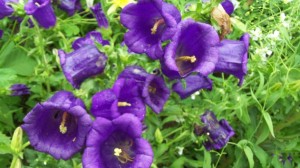 Although there was a lack of light, an essential component to most plant life, this dweller was able to grow a tree and a few other plant species! I really think this, among other presentations, really sparked within me a motivation to think about areas of life we tend to not think about. The presentations gave me ideas on how the horticultural industry is evolving, how that will shape our future landscapes and how to have some spark and ingenuity in the garden. And what is a garden conference without touring gardens? The conference offered tours of the following, world class gardens: Longwood Gardens: Pennsylvania, Winterthur Estate Gardens: Delaware, Chanticleer Garden: Pennsylvania, Mt. Cuba Center: Delaware. Although all the gardens offered something unique, I highly enjoyed Mt. Cuba Center in Delaware. Prior to becoming a lush woodland wildflower gardens, the land was an abandoned corn field located in the Appalachian Piedmont region. The land was transformed by Mr. and Mrs. Lammot du Pont Copeland. I think I loved this one so much because it sparks my interest in use of native plants, thus, fostering native species and ecosystems. The experiences we had most certainly benefited our future pursuits. We would like to thank all those who made our trip possible. Thank You!
Although there was a lack of light, an essential component to most plant life, this dweller was able to grow a tree and a few other plant species! I really think this, among other presentations, really sparked within me a motivation to think about areas of life we tend to not think about. The presentations gave me ideas on how the horticultural industry is evolving, how that will shape our future landscapes and how to have some spark and ingenuity in the garden. And what is a garden conference without touring gardens? The conference offered tours of the following, world class gardens: Longwood Gardens: Pennsylvania, Winterthur Estate Gardens: Delaware, Chanticleer Garden: Pennsylvania, Mt. Cuba Center: Delaware. Although all the gardens offered something unique, I highly enjoyed Mt. Cuba Center in Delaware. Prior to becoming a lush woodland wildflower gardens, the land was an abandoned corn field located in the Appalachian Piedmont region. The land was transformed by Mr. and Mrs. Lammot du Pont Copeland. I think I loved this one so much because it sparks my interest in use of native plants, thus, fostering native species and ecosystems. The experiences we had most certainly benefited our future pursuits. We would like to thank all those who made our trip possible. Thank You!
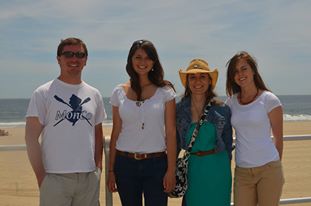 And if that is not enough! Shortly after this conference I attended the Wyoming Federation of Garden Clubs conference very briefly. At the conference I was awarded a scholarship from the Wyoming Federation of Garden Clubs and to my surprise the June P. Wood Scholarship awarded by the National Garden Clubs Inc. I can never emphasize enough how much these scholarships help to fund my pursuits in higher education. With the help of generous donors my goals become possible to achieve. I hope by receiving such awards it will motivate students in my same area of study to apply.
And if that is not enough! Shortly after this conference I attended the Wyoming Federation of Garden Clubs conference very briefly. At the conference I was awarded a scholarship from the Wyoming Federation of Garden Clubs and to my surprise the June P. Wood Scholarship awarded by the National Garden Clubs Inc. I can never emphasize enough how much these scholarships help to fund my pursuits in higher education. With the help of generous donors my goals become possible to achieve. I hope by receiving such awards it will motivate students in my same area of study to apply.
As always there is much to share, until next posting, farewell.
